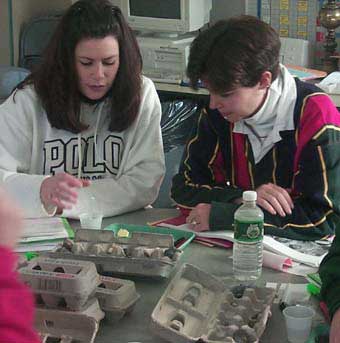 |
|
|
Poster Presentation Full Text: Preserving ASSET through a Shared Vision of Continuous Improvement in Teaching Quality: From an emphasis on hands-on to inquiry Poster presentations are composed in four parts:
|
|
We achieved our first goal of getting hands-on materials into classrooms. ASSET Inc, founded by Bayer Corporation in 1994, piloted the comprehensive program for systemic reform that we learned from the National Science Resources Center in two school districts in Allegheny County. By 1995, we were delivering STC (Science and Technology for Children) and FOSS (Full Option Science System) materials to 1,020 teachers in 16 school districts, by 2001 to classrooms in 69 school districts. Use estimates are at 95%.
In those early days, I hoped that our university and informal science partners would adopt coordination of professional development, but it turns out that while we work closely with partners, districts look to ASSET for professional development because teacher leaders conduct all sessions. Our learning curve on what was needed to support the improvement in teaching quality was steep. We came to understand the impact of inquiry from the Institute for Inquiry at the Exploratorium, and only yesterday at the final session of a study group on inquiry, do we have concrete evidence that teachers are changing their practice.
Aligned assessment of student learning was assumed and has been a component of professional development. However, using performance-based assessment requires a radically different approach, which needed to be learned first.
In the past year, we have come to realize that mechanisms for continuous improvement for teaching need to be continued and hoped districts would share our vision and pay the necessary fee to continue these efforts. Reform takes longer than five years. We've only set the stage.
Partners of all kinds have been and continue to be critical. We all believe that "a closed system can't regenerate," but we know we are countering the tendency to isolation in the classroom and in the school and in the district all the time.

( BACK TO POSTER | BACK TO TOP )
Nothing is impossible if we keep student learning as the focus. School districts, community groups, and local business and family foundations have been amazed by what we have accomplished. We have established the following:
The external assessment required under the core evaluation for the LSC, especially the results of the student assessment, have had a major impact on our ability to tell the story. To see the results, go to our website ( www.assetinc.org ) and look up the Results Report.
( BACK TO POSTER | BACK TO TOP )
One organizational thing I would do if we were starting over is to have a school district fee for professional development in addition to the fee for materials. One programmatic thing I would do differently is to organize an administrative component right along with the teacher professional development. Our partnership with the Principals Academy has enriched the program and its support system for teachers tremendously. We find that principals have the same learning curve as teachers regarding the benefits of standards-based teaching and learning, as well as the complexity of translating it into classroom practice. A case in point would be that under the comprehensive levels of the new fee structure, districts pay into the position of a Coalition Resource Teacher (on loan from a district for 2 years), whose services are shared by a small group of districts. This method is institutionalizing the concept of teacher leaders as partners and colleagues with principals.
( BACK TO POSTER | BACK TO TOP )
( BACK TO POSTER | BACK TO TOP )
ASSET District Membership Options
1. Entry level - $225 per teacher, provides
2. Menu-driven level - a membership fee based on district size, provides
3. Basic Comprehensive level - $450 per teacher plus a contribution toward a Resource Teacher based on building size, provides
4. Continuous Improvement Comprehensive level - $600 per teacher plus a contribution toward a Resource Teacher based on building size, provides
THIS POSTER WAS PREPARED BY:
Reeny D. Davison of the ASSET (Allegheny Schools Science Education and Technology) Inc project.
( BACK TO POSTER | BACK TO TOP )
|